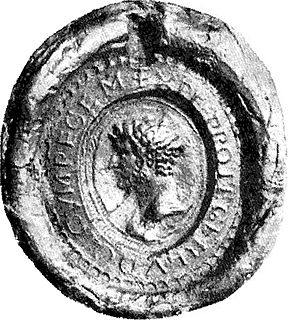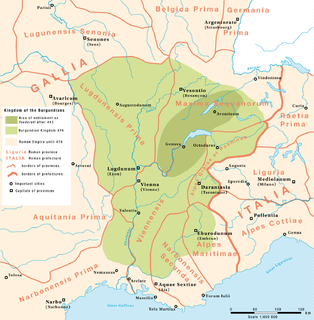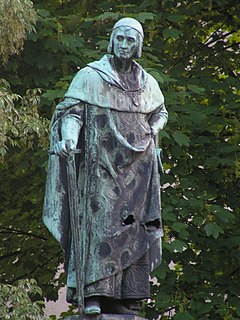Biography
Ruotger was born to a noble family, probably in Lotharingia, possibly from the region north of Metz, around Thionville. He had a brother named Beroald, a layman, who was accused by Eberwin of Tholey a century later of having usurped the abbey of Saint Martin in Trier after the death of Abbot Regino. He also had a wealthy niece in the Rizzigau. Nothing is known of Ruotger's life before his elevation to the archdiocese in 915. His predecessor, Radbod, died on 30 March that year. It is probable that Ruotger was chosen as his successor in a free election by the cathedral chapter, since in 928 the church had been granted that privilege by King Charles the Straightforward. Nonetheless, it is probable that the choice of Ruotger was in conformity with the king's wishes, since Trier was at the time the chief city of Lotharingia, which had only been joined to Charles's kingdom in 911.
As Charles's archchancellor for Lotharingia from January 916, Ruotger had a large role in securing the king's authority in Lotharingia, culminating in the Treaty of Bonn in 921, in which the East Frankish king, Henry the Fowler, recognised Lotharingian as belonging to West Francia. Ruotger also became involved in a conflict with Giselbert, duke of Lotharingia, over the basilica of Saint Servatius in Maastricht.
In June 922, Charles's domestic opponents declared him deposed, electing and crowning Robert, Count of Paris, in his place. Charles was forced to retreat with his supporters into Lotharingia. Ruotger, erstwhile archchancellor, does not appear to have attended Charles's court there, for he is not mentioned in any further royal documents. It may be that he had gone over to Robert, or else that he was already supporting a bid by Henry the Fowler for Lotharingia. In June 923, Robert was killed at the battle of Soissons, but Charles's was defeated and shortly afterwards captured. Henry took the opportunity to invade Lotharingia and besiege Metz. By this time Ruotger had clearly abandoned the king, for he was present with Henry's army at the siege of Metz. Ruotger's support for Henry carried with it that of the Lotharingian church. By 925 the East Frankish annexation was complete, and in 927 Henry appointed Ruotger as his Lotharingian archchancellor.
As a clergyman, Ruotger's primary concern was the renewal of the Lotharingian church in the aftermath of Viking and Hungarian raids, which had taken a physical toll on the churches and disrupted ecclesiastical structures. It was in this context that, in 927×929, Ruotger held a provincial synod attended by the bishops of Metz, Toul and Verdun. It was probably for this occasion that he composed a capitula episcoporum, a manual for ecclesiastical practices and the subdiocesan level. Such instruments were common during the earlier Carolingian epoch, and Ruotger's is the last one from Lotharingia. Only 28 of its chapters survive in later manuscripts: one tenth-century and another twelfth-century manuscript from West Francia, and a twelfth-century East Frankish manuscript. It probably never circulated much beyond the province of Trier, and it owed more to West Frankish exemplars than East Frankish ones. It was partially modeled on the capitula drawn up by Archbishop Radulf of Bourges in 853. Several of its chapters match canons from the provincial synod, but it cannot be determined which came first. The provincial canons, titled Sermo in synodo faciendus as if they were a sermon delivered by Ruotger to his assembled bishops, were only discovered in a Viennese manuscript in the early 1980s.
Ruotger was buried in the chapel dedicated to Saint Walpurga in the church of Sankt Paulin in Trier. His gravestone was still visible in the 17th century.

Henry the Fowler was the Duke of Saxony from 912 and the King of East Francia from 919 until his death in 936. As the first non-Frankish king of East Francia, he established the Ottonian dynasty of kings and emperors, and he is generally considered to be the founder of the medieval German state, known until then as East Francia. An avid hunter, he obtained the epithet "the Fowler" because he was allegedly fixing his birding nets when messengers arrived to inform him that he was to be king.

Louis the German, also known as Louis II, was the first king of East Francia, and ruled from 843–876 AD. Grandson of emperor Charlemagne and the third son of Louis the Pious, emperor of Francia, and his first wife, Ermengarde of Hesbaye, he received the appellation Germanicus shortly after his death in recognition of Magna Germania of the Roman Empire, reflecting the Carolingians' assertions that they were the rightful descendants of the Roman Empire.

Charles the Bald was a 9th-century king of West Francia (843–877), king of Italy (875–877) and emperor of the Carolingian Empire (875–877). After a series of civil wars during the reign of his father, Louis the Pious, Charles succeeded, by the Treaty of Verdun (843), in acquiring the western third of the Carolingian Empire. He was a grandson of Charlemagne and the youngest son of Louis the Pious by his second wife, Judith.

Charles III, called the Simple or the Straightforward, was the King of West Francia from 898 until 922 and the King of Lotharingia from 911 until 919–23. He was a member of the Carolingian dynasty.

Regino of Prüm or of Prum was a Benedictine monk, who served as abbot of Prüm (892–99) and later of Saint Martin's at Trier, and chronicler, whose Chronicon is an important source for late Carolingian history.

Lotharingia was a medieval successor kingdom of the Carolingian Empire and a later duchy of the Ottonian Empire, comprising the present-day Netherlands, Belgium, Luxembourg, North Rhine-Westphalia (Germany), Rhineland-Palatinate (Germany), Saarland (Germany), and Lorraine (France). It was named after King Lothair II who received this territory after the kingdom of Middle Francia of his father Lothair I was divided among his sons in 855.

Zwentibold, a member of the Carolingian dynasty, was the illegitimate son of Emperor Arnulf. In 895, his father, then king of East Francia, granted him the Kingdom of Lotharingia, which he ruled until his death. After his death he was declared a saint and martyr by the Catholic Church.
Conrad, called the Red, was Duke of Lorraine from 944 until 953. He became the progenitor of the Imperial Salian dynasty.

The Duchy of Lower Lotharingia, also called Northern Lotharingia, Lower Lorraine or Northern Lorraine, was a stem duchy established in 959, of the medieval Kingdom of Germany, which encompassed almost all of the modern Netherlands, central and eastern Belgium, Luxemburg, the northern part of the German Rhineland province and the eastern parts of France's Nord-Pas de Calais region.

Kingdom of Burgundy was a name given to various states located in Western Europe during the Middle Ages. The historical Burgundy correlates with the border area of France, Italy and Switzerland and includes the major modern cities of Geneva and Lyon.

The terms Kingdom of Germany or German Kingdom denote the mostly Germanic-speaking Eastern Frankish kingdom, which was formed by the Treaty of Verdun in 843, especially after the kingship passed from Frankish kings to the Saxon Ottonian dynasty in 919. The king was elected, initially by the rulers of the stem duchies, who generally chose one of their own. After 962, when Otto I was crowned emperor, East Francia formed the bulk of the Holy Roman Empire, which also included the Kingdom of Italy and, after 1032, the Kingdom of Burgundy.
Gilbert was son of Reginar and the brother-in-law of the Ottonian emperor, Otto I. He was duke of Lotharingia until 939. Gilbert was also lay abbot of Echternach, Stablo-Malmedy, St Servatius of Maastricht, and St Maximin of Trier.
Wigeric or Wideric was the count of the Bidgau and held the rights of a count within the city of Trier. He received also the advocacy of the Abbey of Saint Rumbold at Mechelen from Charles III of France. From 915 or 916, he was the count palatine of Lotharingia. He was the founder of the House of Ardennes.

Sigfried was count of the Ardennes and the first person to rule Luxembourg. He was an advocate of the abbeys of St. Maximin in Trier and Saint Willibrord in Echternach. His mother was Cunigunde who was a granddaughter of Louis II, king of France. Cunigunde had at least two husbands but Sigfried's father was most likely Count Palatine Wigeric of Lotharingia.

Baldwin of Luxembourg was the Archbishop-Elector of Trier and Archchancellor of Burgundy from 1307 to his death. From 1328 to 1336, he was the diocesan administrator of the archdiocese of Mainz and from 1331 to 1337 of those of Worms and Speyer. He was one of the most important German prelates of his age.
Liutbert was the Archbishop of Mainz from 863 until his death. He also became Abbot of Ellwangen in 874 and is reckoned the first Archchancellor of Germany. He was one of the major organisers – along with Henry of Franconia – of the vigorous and successful defence of East Francia against Viking attack during his last decade.

Louis the Younger, sometimes Louis III, was the second eldest of the three sons of Louis the German and Emma. He succeeded his father as the King of Saxony on 28 August 876 and his elder brother Carloman as King of Bavaria from 880 to 882. He died in 882 and was succeeded in all his territories, which encompassed most of East Francia, by his younger brother, Charles the Fat, already king of Italy and emperor.
Hagano was a petty nobleman (mediocris) who achieved influence in Lotharingia and West Francia during the rule of Charles the Simple (898–922). He was a relative of Charles' first wife, Frederuna, and was originally from Lotharingia. Though Frederuna had died in 917, by 918 Hagano had become the king's favourite and his most trusted advisor. The aristocracy despised him, however, and the authority of Charles over the nobles was severely weakened by Hagano's presence at court. Charles' sin appears to be transferring grants in benefice, especially of monasteries, from his barons to Hagano.

Robert, also spelled Ruotbert or Rotbert, was the archbishop of Trier from 931 until his death. He played a leading role in the politics of both Germany and France, and especially of the Lotharingian territory in between. He was a patron of scholars and writers and a reformer of monasteries.

Adventius was the Bishop of Metz from 855 until his death in 875. He was a prominent figure within the courts of the Carolingian kings Lothar II (855-869) and Charles the Bald (840-877).













